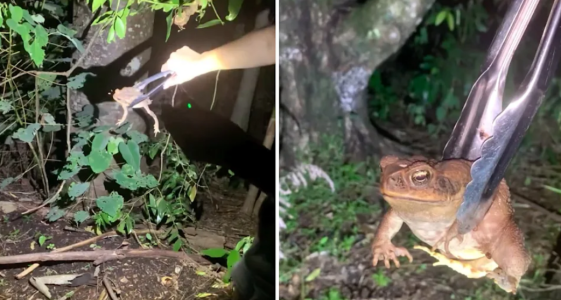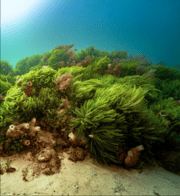Woman takes drastic step to combat invasive species, gets neighbours talking
By
- Replies 13
Australia is known for its remarkable landscapes and distinctive wildlife, but not every creature is a welcome addition.
One unwelcome species has stirred concern for decades, leading to some unusual efforts by locals trying to manage its impact.
Despite ongoing challenges, the fight to curb its spread shows no signs of slowing down.
One such Australian is Cassie Fenton, a 29-year-old resident of the Sunshine Coast, who has taken the fight against cane toads into her own hands—quite literally.
Armed with tongs and a black bin bag, Cassie has been trying to rid her backyard of these toxic creatures.
'I've caught 214 cane toads in just 12 nights in my backyard,' Cassie said.

'I catch them with tongs. They're my dedicated toad tongs, as you can't use them for food due to the toad's poison. Then I put them into a container,'
Cassie's nightly routine involves donning a head torch and using her 'dedicated toad tongs' to collect the nocturnal pests.
She then humanely euthanises them using methods recommended by the RSPCA.
Cassie's dedication to the cause is so strong that she even purchased a second-hand fridge and freezer specifically to execute the stepped hypothermia method of euthanasia, which involves first anesthetising the toads at four degrees Celsius before freezing them at -20 degrees to end their lives painlessly.
'I actually got a second-hand fridge and freezer from Facebook Marketplace for $50. Otherwise, I would not be doing this option because I don't want toads in my fridge,' she said.
These amphibians are more significant than many native species and carry a toxin lethal to much of Australia's native wildlife.
Since their introduction to control pest beetles in sugar cane crops—a move that proved ineffective—cane toads have spread across Queensland, the Northern Territory, Western Australia, and the northern coast of New South Wales.
The National Museum of Australia estimates that cane toads are advancing at 40 to 60 kilometres per year, and authorities have conceded that a broad-scale method to control the species is unlikely to be found.
This makes individual efforts like Cassie's all the more critical in protecting vulnerable native species.
For those of us who are passionate about preserving Australia's natural heritage, Cassie's story is a call to action.
While not everyone may be able to go to the lengths of buying a second-hand fridge for toad control, there are other ways to contribute.
Awareness of the issue, support for local wildlife conservation efforts, and even participation in community toad-catching events can make a difference.
Remember, if you're dealing with cane toads or any other invasive species, always follow humane and safe practices.
If you're unsure, contact local wildlife authorities or the RSPCA for guidance.
Your actions can help safeguard our environment for future generations to enjoy.
Credit: Instagram
Credit: Instagram
Credit: Instagram
 Have you encountered cane toads in your area? What measures have you taken or seen others take to control this invasive species? Share your stories and tips in the comments below.
Have you encountered cane toads in your area? What measures have you taken or seen others take to control this invasive species? Share your stories and tips in the comments below.
One unwelcome species has stirred concern for decades, leading to some unusual efforts by locals trying to manage its impact.
Despite ongoing challenges, the fight to curb its spread shows no signs of slowing down.
One such Australian is Cassie Fenton, a 29-year-old resident of the Sunshine Coast, who has taken the fight against cane toads into her own hands—quite literally.
Armed with tongs and a black bin bag, Cassie has been trying to rid her backyard of these toxic creatures.
'I've caught 214 cane toads in just 12 nights in my backyard,' Cassie said.

Toxic cane toads have been captured and humanely euthanised in a Sunshine Coast backyard by a resident. Credit: @cassiefenton / Instagram
Cassie's nightly routine involves donning a head torch and using her 'dedicated toad tongs' to collect the nocturnal pests.
She then humanely euthanises them using methods recommended by the RSPCA.
Cassie's dedication to the cause is so strong that she even purchased a second-hand fridge and freezer specifically to execute the stepped hypothermia method of euthanasia, which involves first anesthetising the toads at four degrees Celsius before freezing them at -20 degrees to end their lives painlessly.
'I actually got a second-hand fridge and freezer from Facebook Marketplace for $50. Otherwise, I would not be doing this option because I don't want toads in my fridge,' she said.
These amphibians are more significant than many native species and carry a toxin lethal to much of Australia's native wildlife.
Since their introduction to control pest beetles in sugar cane crops—a move that proved ineffective—cane toads have spread across Queensland, the Northern Territory, Western Australia, and the northern coast of New South Wales.
The National Museum of Australia estimates that cane toads are advancing at 40 to 60 kilometres per year, and authorities have conceded that a broad-scale method to control the species is unlikely to be found.
This makes individual efforts like Cassie's all the more critical in protecting vulnerable native species.
For those of us who are passionate about preserving Australia's natural heritage, Cassie's story is a call to action.
While not everyone may be able to go to the lengths of buying a second-hand fridge for toad control, there are other ways to contribute.
Awareness of the issue, support for local wildlife conservation efforts, and even participation in community toad-catching events can make a difference.
Remember, if you're dealing with cane toads or any other invasive species, always follow humane and safe practices.
If you're unsure, contact local wildlife authorities or the RSPCA for guidance.
Your actions can help safeguard our environment for future generations to enjoy.
Credit: Instagram
Credit: Instagram
Credit: Instagram
Key Takeaways
- Cassie Fenton has taken personal action against the invasion of toxic cane toads by capturing and humanely euthanising them in her backyard on the Sunshine Coast.
- She has removed over 200 cane toads using tongs, a container, and a head torch, following RSPCA-recommended methods for humane euthanasia.
- The invasive species introduced to control sugarcane crop pests has become a threat to native wildlife due to its size, toxicity, and rapid spread across Australia.
- Cassie purchased a second-hand fridge specifically to implement the stepped hypothermia method of euthanasia, highlighting the lengths individuals are going to in order to control the cane toad population.







